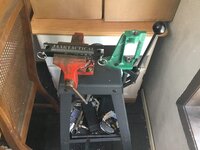- Messages
- 277
- Reactions
- 271
- Thread Starter
- #41
@mignuc Awesome. Another few questions of mine answered, that I hadn't asked yet. You should do this professionally, haha.
The Berdan primer thing was one I was curious about. I'd only done a cursory search of whether or not it was possible and found the usual 100 "no it's not" to the 1 or 2 "yes it is". And I've come across the reforming .223 and a couple other cases to make 7.62x38r, which sounds time consuming, not fun at all, and like a load of fun, hahaha.
Appreciate the suggestions on particular single stages. That aligns pretty well with what I'd found for prices. I think I'm just going to have to wait until I know I have all the other basics I need, see if I have any budget left, or wait to get a screaming deal on a used, useable single stage, unfortunately, so I likely won't be starting with one. I appreciate the challenge more now with using a progressive as a single stage. The mechanical advantage differences between single stage and progressive should've been more clear to me before, but i wasn't thinking, so thanks to a couple of ya'll for clearing that up. Unfortunately, like I said, I'm not going to have much choice, haha. Needs must, and all that.
-Mike
The Berdan primer thing was one I was curious about. I'd only done a cursory search of whether or not it was possible and found the usual 100 "no it's not" to the 1 or 2 "yes it is". And I've come across the reforming .223 and a couple other cases to make 7.62x38r, which sounds time consuming, not fun at all, and like a load of fun, hahaha.
Appreciate the suggestions on particular single stages. That aligns pretty well with what I'd found for prices. I think I'm just going to have to wait until I know I have all the other basics I need, see if I have any budget left, or wait to get a screaming deal on a used, useable single stage, unfortunately, so I likely won't be starting with one. I appreciate the challenge more now with using a progressive as a single stage. The mechanical advantage differences between single stage and progressive should've been more clear to me before, but i wasn't thinking, so thanks to a couple of ya'll for clearing that up. Unfortunately, like I said, I'm not going to have much choice, haha. Needs must, and all that.
-Mike







 But I'll start perusing the listings here and if I find a decent single stage for less than a hundred I know I can afford, I'll think about getting it, k?
But I'll start perusing the listings here and if I find a decent single stage for less than a hundred I know I can afford, I'll think about getting it, k?




